AMD’s RX 7000-series graphics cards are right around the corner and they have drummed up a lot of excitement in the gaming and enthusiast audiences for a range of reasons. Chiefly among them, however, is how they look set to offer truly credible competition for Nvidia’s incredibly powerful RTX 4090 and RTX 4080 graphics cards.
But that’s not all. There’s improved ray tracing performance, a new process node, and at the heart of the new cards, a brand new architecture on a brand new chiplet design.
This is a major overhaul for AMD, not only reinventing the wheel with a multi-core design (akin to its post-Zen 2 Ryzen CPUs) but it’s making it run very, very fast as well. All of this makes these cards not only incredibly capable, but potentially more efficient, and much more affordable than the competition too.
With promises of lower prices, lower power demands, and sky-high performance, AMD’s next-generation graphics are incredibly exciting. Let’s take a look at the new RDNA 3 architecture, and two of the first cards of the line: the RX 7900 XT and 7900 XTX.
Radeon RX 7000 Series – An Overview
AMD’s RX 7000 generation of graphics cards is an important one. Building on the success of its RDNA 2 GPUs, this new line of RDNA 3 graphics cards is designed to keep AMD as the value-orientated brand, whilst still providing credible top-tier performance. That’s a tricky line to walk, but AMD is throwing itself into it with a hot new generation of intriguing graphics cards.
At the core of this new line is the overhauled GPU design. Where Nvidia’s latest, and all of AMD’s GPUs until now, are based on a monolithic die design – a single large chip that houses everything to do with the GPU – RDNA 3 changes things up in a big way. It uses a chiplet-based approach, which is similar, though not the same, as its Ryzen and Epyc lines of central processors.
The 7900 XTX and 7900 XT are built with a single graphics compute die (GCD) based on the TSMC 5nm process, and six memory cache dies (MCD) based on the 6nm TSMC process. This design helped AMD simplify the design process, by allowing I/O and cache to be built on more mature processes. That means fewer engineers during the design process, and yield is far better for both the 5nm and 6nm chips because they can be more effectively fitted within the large wafers during production.
This saves AMD and the consumer money, but also opens up some exciting performance potential. It lets AMD focus its attention on improving the performance of the logic portions of the GPU, without the need to radically redesign the I/O or cache portions of the die. It does mean AMD had to design a new Infinity Link system to connect the different chiplets together with minimal latency and maximum bandwidth.
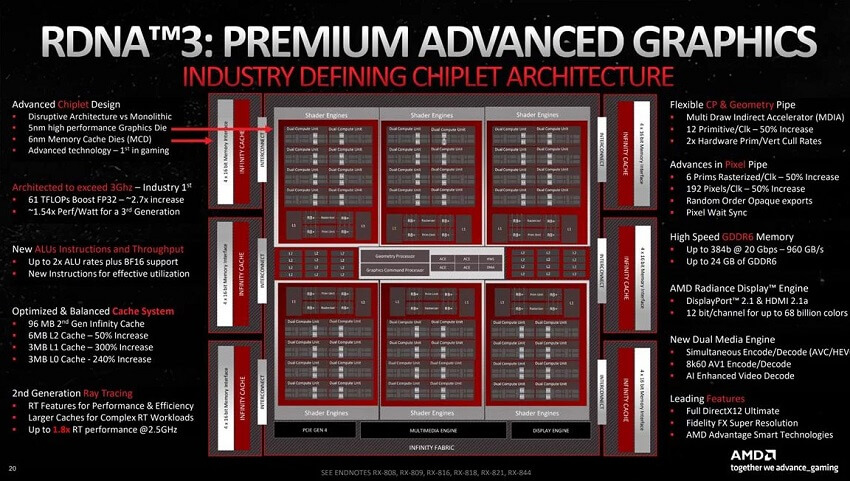
Designing the new generation
To design such an interlink, AMD used a mobile design called Fanout, which AMD enhanced to operate at up to 9.2 Gbps, calling the resulting design High-Performance Fanout. That’s almost 10 times the speed of the Infinity Fabric used in Ryzen and Epyc CPUs. It’s also impressively energy efficient, which is at least partly why AMD was able to keep its cards’ TDPs relatively modest.
The RDNA 3 architecture that makes up each of the GPU chiplets has also seen some major overhauls. AMD hasn’t gone into explicit detail about the new architecture just yet, but has detailed some exciting new features. There are new ray accelerators which should enhance ray tracing performance by up to 50% per compute unit, as well as new AI accelerators which will enhance specific tasks in certain applications for additional performance where it counts.
The combination of the new chiplet approach, larger and faster infinity cache, the new MCD interlinks, and advances in the pixel pipeline should ultimately give the RX 7000 cards a more than 50% improvement in performance per watt over RDNA2. That’s a big leap and should see these cards compete with some of the best from Nvidia.
The new AMD Radiance Display Engine gives the new RX 7000 cards support for 12-bit HDR colour and they’ll have several DisplayPort 2.1 and USB-C ports, giving the cards support for even higher resolution and refresh rates for future compatibility and maximum performance in high-FPS esports games.
RDNA 3 also introduces a new media engine, with AV1 encoding, making the new RX 7000 cards exciting options for streamers and video editors; especially if they work with ultra-high definition video at 8K and beyond.
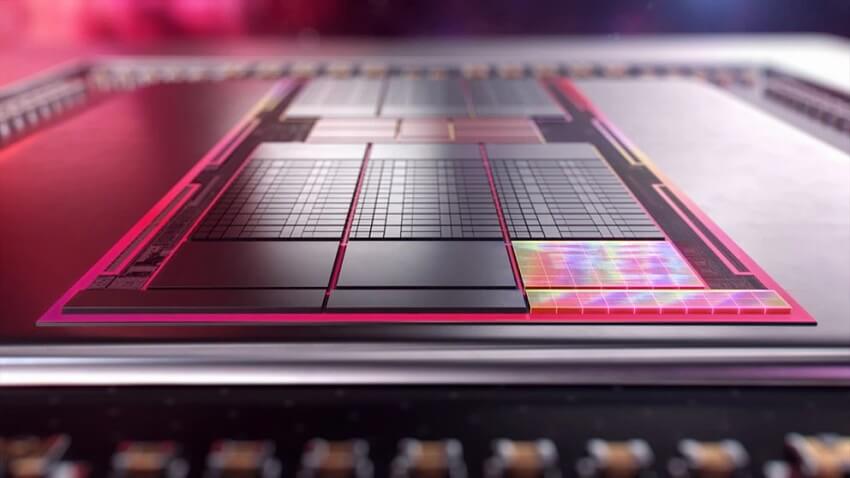
7900 XTX vs. 7900 XT Specifications
While we don’t have much in the way of real-world performance numbers for these cards, the specifications of the new graphics cards are incredibly important. They give us a good idea of how we can expect the cards to perform in isolation, and when facing off against competition from the new and previous generations.
| RX 7900 XTX | RX 7900 XT | RX 6950 XT | RX 6900XT | |
| Architecture | RDNA 3 | RDNA 3 | RDNA 2 | RDNA 2 |
| GPU | Navi 31 | Navi 31 | Navi 21 | Navi 21 |
| Process node | TSMC 5nm (GCD), TSMC 6nm (MCD) | TSMC 5nm (GCD), TSMC 6nm (MCD) | TSMC 7nm | TSMC 7nm |
| Compute Units | 96 | 84 | 80 | 80 |
| Shading units | 6144 | 5376 | 5120 | 5120 |
| Ray acclerators | 96 | 84 | 80 | 80 |
| Game clock | 2300MHz | 2000MHz | 2100MHz | 2015MHz |
| Boost clock | Up to 2500MHz | Up to 2400MHz | Up to 2310MHz | Up to 2250MHz |
| Memory | 24GB GDDR6 | 20GB GDDR6 | 16GB GDDR6 | 16GB GDDR6 |
| Memory speed | 20Gbps | 20Gbps | 18Gbps | 16Gbps |
| Memory bus width | 384-bit | 320-bit | 256-bit | 256-bit |
| Infinity Cache | 96MB | 80MB | 128MB | 128MB |
| Memory bandwidth | 960 GBps | 800 GBps | 576 GBps | 512 GBps |
| TDP | 355W | 335W | 335W | 300W |
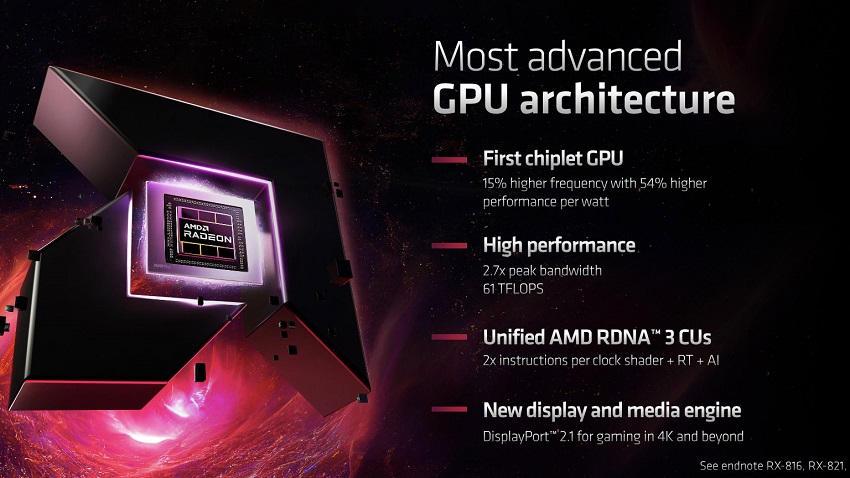
Spec Analysis
Both new cards are based on the same GPU, running the same architecture on the same process nodes. That’s because in reality, the 7900 XTX is the fully unlocked version of the Navi 31 GPU, while the 7900 XT uses a slightly cut-down version. That’s why the XTX comes with 96 compute units, with 96 ray accelerators, and 6,144 shading units. The 7900 XT is slightly behind that with 84 compute units, and 5,376 shading units, giving the XTX around 14% more in total.
That’s not a dramatic amount, but when combined with the disparity in clock speeds, may make the 7900 XTX significantly faster in some settings. The 2,500 MHz boost clock is only 100MHz higher than the 7900 XT model’s clock, but it’s the game clock that is more impactful here. The 7900 XTX will reportedly sit around 2,300MHz during gaming, while the XT will rest closer to 2,000MHz.
What’s quite exciting there, though, is that the 7900 XT can hit a 2,400MHz boost clock, albeit for short periods of time. That may mean that with the right cooling, and some third-party adjustments to power limits, the standard 7900 XT might be able to overclock to near 7900 XTX speeds, closing that performance gap significantly.
But what about the 7900 XTX? Although it is already running at high clock speeds with a high power draw, AMD has said that the RDNA 3 architecture was designed with 3GHz frequencies in mind. AMD doesn’t offer anything close to that, but it’s possible that we’ll see third-party cards from board partners that stretch the limits of what’s possible with this new GPU design.
If they can get even close to 3GHz, Nvidia is going to have a lot to worry about.
RX 7000 Series Memory and power
Both cards feature a lot of GDDR6 memory – vastly more than the previous generation too, which topped out at 16GB. The additional 4GB of memory on the XTX is unlikely to make a huge difference – very few games utilize that much memory at even 4K as it stands. However, the difference in memory bus width will benefit the XTX model, since it helps increase overall bandwidth to near 1GBps, and that’s without the added acceleration of the Infinity Cache.
Total infinity cache is smaller on the new cards, but it’s a new generation of it that operates at far higher speeds, delivering much greater overall bandwidth, and reduced latency in turn.
Power differences between the cards aren’t huge, with only a 20W difference when they’re running flat out. This is also notable because AMD hasn’t increased its flagship cards’ power draw by much this generation. The 7900 XT has the same power draw as the last-generation kingpin, the RX 6950XT, while the 7900 XTX demands an additional 20W. Both cards are, however, more power-hungry than the launch flagship of the RDNA2 era, the 6900 XT, which pulled just 300W.
How fast are the 7900 XTX and 7900XT?
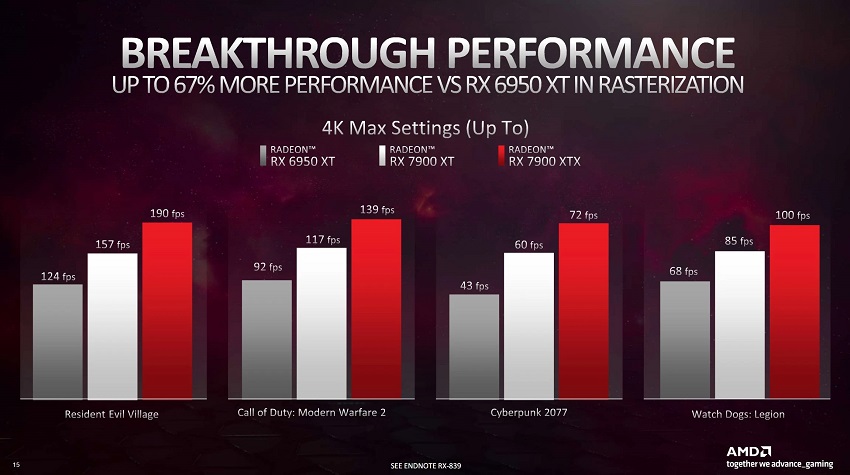
For now, we don’t know for sure, as the cards aren’t officially out and there are no published third-party testing numbers. Even if we did have our hands on these cards to try them out ourselves, we wouldn’t legally be allowed to tell you what they can do. Not yet.
What we can do, though, is look at AMD’s own first-party numbers. At the debut event for RDNA 3 in November, AMD released a number of benchmark results with frame rates for both of its top new cards and compared them to their last-generation AMD counterparts, like the 6900 XT and 6950 XT.
Since both the 7900 XT and 7900 XTX are 4K gaming cards, AMD focused on 4K gaming performance in its unveiling. Slides show the 7900 XTX and XT handily beating the 6950 XT in games like Resident Evil Village, Call of Duty: Modern Warfare 2, Cyberpunk 2077, and Watch Dogs Legion. In rasterization testing, the 7900XT and XTX performed up to 67% faster than the last-generation flagship, and were even faster in ray tracing scenarios, where they were up to 87% faster.
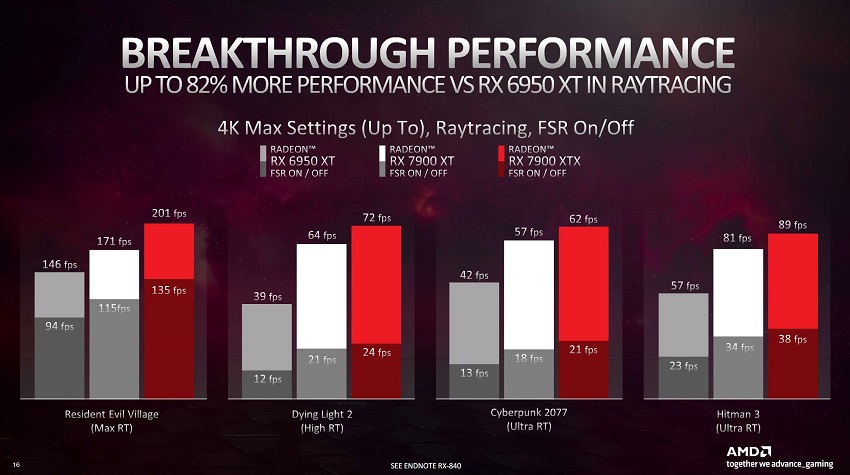
We don’t have any direct comparisons with Nvidia’s new RTX 4000 cards as of yet. AMD could have compared these cards to the 4090, but they’d have lost. It’s clear that the 4090 will be the fastest GPU this generation, but AMD’s cards are far cheaper than that monster. Instead, its cards are designed to lock horns with the RTX 4080, and AMD has said – without benchmark results, for now – that the XTX should prove faster than the 4080 in general rasterization.
Considering both cards are currently slated to sell for considerably less than the 4080 too, that should give Nvidia pause for thought.
Power and efficiency
There’s been a trend in recent graphics and CPU generations to increase power consumption to gain additional performance. In many ways that’s fine, but at a certain point these PCs start to get very hot and expensive to run. The Radeon RX 7900 XTX and XT aren’t too demanding at just over 300W, but that still means over 500W of consistent use during gaming with a mid-tier CPU and the rest of your system components.
That’s a lot better than Nvidia’s RTX 4090, which can pull close to 500W by itself, but it’s still a lot and means relatively high power costs, as well as a demand for additional system cooling to vent all that hot air out of your PC.
One benefit of AMD’s cards over any of Nvidia’s recent high-end models, is that they use the standard 8pin power supply connectors. That improves compatibility with a wider range of power supplies and means you needn’t fear the melting and fire hazard problems some RTX 4000-series GPUs have faced since launch.
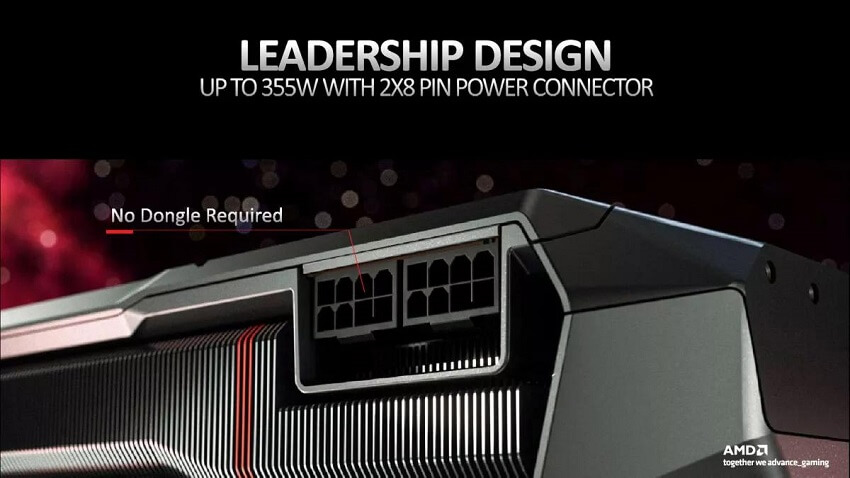
FSR 3
Like RDNA 2, RX 7000 graphics cards will support FidelityFX Super Resolution (FSR), but in 2023, AMD is set to launch FSR 3.
Like DLSS 3 from Nvidia, FSR 3 is set to introduce frame generation to massively improve FSR performance. It’s not year clear whether FSR 3 will use machine learning and require bespoke hardware, which would lock it down to the RX 7000-series, but it seems likely that the RX 7000 GPUs will be best placed to take advantage of it, whether through software optimization, or specific hardware acceleration.
RX 7000 Series Release date
The AMD Radeon RX 7900 XTX and 7900XT will both launch officially on December 13, giving everyone a quick opportunity before the Christmas period to get their hands on one. Prices may fluctuate a lot during the first few weeks after launch while supply and demand balance out.
One place you can guarantee will have an extensive stock of the new cards and where prices will remain fair, is Chillblast. Keep an eye on our social feeds and pre-built gaming PCs. When these cards launch we’ll have several configurations using them shortly after.
Conclusion
The RX 7900XT and 7900XTX may not be here quite yet, but they’re not far off and the performance they promise looks intriguing. Just as impactful on the state of the industry and gaming, however, will be pricing and power concerns. These cards look set to be a lot cheaper than Nvidia’s alternative. Will that lead to team green lowering prices in turn, or will AMD start to see much greater adoption?
These are still expensive cards, so they won’t sell in huge numbers to start, but the potential is there for RDNA 3 to really shake up the graphics industry.






